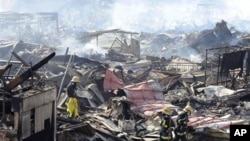Students in the United States are working with others in Japan to gather urgent information from social networking websites, such as Twitter and Facebook, to help create a map pinpointing crisis areas across the island nation.
Just hours after a massive earthquake and tsunami devastated northeast Japan, students half-a-world away reacted. A group in Boston, in the northeastern U.S. state of Massachusetts, started going through thousands of Internet messages, trying to pull together a map of what was happening on the ground in Japan.
Student Robert Berry at Tufts University in Boston says their goal is to help the relief effort. "So it’s basically ‘crisis mapping.’ Mapping out the crisis for people on the ground, either victims or agencies that are going to respond so they have a better picture," he said.
People have been using this type of technology since political turmoil hit Kenya during its elections in 2008. And it was used again in Haiti after the 2010 earthquake and in Libya during its recent political upheaval.
|
Social Media: Disaster in Japan The Crisis Commons volunteer community has mobilized, and part of the effort is being coordinated by Japanese students at U.S. universities. The Red Cross has opened a page on causes.com to raise money for the victims of Friday's disaster in Japan. For more on how you can help, visit http://bit.ly/gD8At1 and Time Out Tokyo. Google has launched a service for people seeking to reconnect with those in the disaster area. The State Department tweeted: |
Berry describes what they are looking for in this disaster. "They see a fire at a hospital or they see people trapped under a building or something or they know that somebody is trapped there, what they can do assuming that they have the access, they can then tweet that information, and then we find it, bring it to the interface," he said.
In a tech-savvy country like Japan, Berry says the information his colleagues and Japanese counterparts are gathering is helping put together a more accurate picture, as well as a human face to the tragedy. "It brings the situation to you like never before," he said.
Leaders with Crisis Commons, a global network of computer users working in crisis response, say the students are part of a growing international community of volunteers who can quickly sift through large amounts of data to create comprehensive maps of information.
They say that within 24 hours of the Japan disaster there were 75 people around the world, including students at the American universities Harvard and the Massachusetts Institute of Technology putting together details on where people are, as well as the conditions of local roads and transportation.









